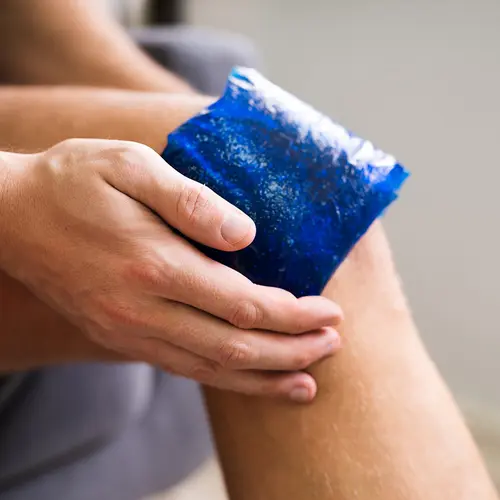If you’re living with psoriatic arthritis (PsA), you know it causes inflamed joints and happens to some people with the skin condition psoriasis. But did you know there are five types?
One form, called axial psoriatic arthritis, mainly affects your spine. If you have axial PsA, your rheumatologist (arthritis doctor) might talk to you about a related issue called sacroiliitis. That’s the name for inflammation in one or both of the joints where your lower backbone and pelvis connect – your sacroiliac joints.
Sacroiliitis can bring on symptoms like pain in your lower back, butt, or thighs. But the good news is that there are medications that can help you get better.
How Is Axial Psoriatic Arthritis Tied to Sacroiliitis?
Axial psoriatic arthritis is the only type of psoriatic arthritis linked to sacroiliitis, says M. Elaine Husni, MD, MPH, vice chair of rheumatology and director of the Arthritis and Musculoskeletal Center at Cleveland Clinic.
Axial PsA can affect you anywhere along the spine, but it most commonly affects the sacroiliac joints, Husni says. That’s where the first sign of inflammation happens in axial psoriatic arthritis.
Can Other Conditions Cause Sacroiliitis?
Yes. People who don’t have axial psoriatic arthritis can get sacroiliitis for other reasons. Some of the things that can take a toll on the sacroiliac joints and cause sacroiliitis are:
Osteoarthritis. This is the most common type of arthritis, known for its wear-and-tear effect on joints.
Ankylosing spondylitis. This type of inflammatory arthritis affects the spine.
Trauma. This includes things like a fall or car accident.
Pregnancy. Either the hormones your body makes or the weight of the baby could affect the sacroiliac joints.
What Are the Symptoms of Axial Psoriatic Arthritis and Sacroiliitis?
Many people with axial PsA get inflammatory back pain, Husni says. Like the name suggests, it’s caused by inflammation. That makes it different from the kind of back pain that you’d get from things like an injury or poor posture.
You might have:
- A stiff back in the morning
- Back pain that gets better when you’re active and worse when you’re not
- Limited ability to move easily
One of the first signs of inflammatory back pain is sacroiliitis, Husni says.
In general, sacroiliitis can bring on pain that might:
- Show up in your lower back, butt, hip, or thigh
- Get worse after you’ve been sitting or standing for a while, or when you’re getting out of a chair
- Feel sharp or stabbing, or achy and dull
- Flare up after you climb stairs, run, take big strides, or put more weight on one leg
Talk to your doctor if you have any of these symptoms.
How Are Axial Psoriatic Arthritis and Sacroiliitis Diagnosed?
Your doctor will ask you about your symptoms and health history. They’ll give you a physical exam, too. They may ask you to move your body in certain directions and put light pressure on your affected joints.
To diagnose psoriatic arthritis in general, your doctor will probably do X-rays of your painful joints. They might also order an imaging test called an MRI, which makes pictures of the inside of your body. These tests can also help diagnose sacroiliitis.
To rule out other health conditions, the doctor might give you blood tests and have a lab check a sample of fluid from one of your swollen joints.
What Are the Treatments for Axial Psoriatic Arthritis and Sacroiliitis?
Treatment for axial psoriatic arthritis can get your PsA and sacroiliitis under control. They’re not treated separately, Husni says.
If your symptoms are mild, meds called NSAIDs (nonsteroidal anti-inflammatory drugs) are typically the first treatment doctors try. Some NSAIDs you’ve probably heard of are aspirin, ibuprofen, and naproxen.
If you have axial psoriatic arthritis that’s moderate to severe and NSAIDs are not helping, doctors often prescribe meds called DMARDs (disease-modifying antirheumatic drugs). The first type of DMARD they tend to use is called a TNF inhibitor. TNF is a protein your body makes that triggers inflammation. People with psoriatic arthritis have higher levels of it in their blood. A TNF inhibitor lowers those levels, controlling inflammation in your joints and skin.
Can Lifestyle Changes Help, Too?
Yes. When you’re living with a long-term condition like axial psoriatic arthritis, good habits can help boost your overall health. Stick to your treatment plan and try these tips:
Eat a balanced diet. Make sure you get plenty of fresh fruits and vegetables. Cut back on processed foods and fast food.
Move more. If you’re not active now, ask your doctor to help come up with an exercise routine just for you. They may refer you to a physical therapist or an exercise physiologist.
Drop some extra pounds. You can ask your doctor what weight is healthy for you.
Get a good night’s rest. Aim for 7 to 8 hours sleep a night.
If you smoke, quit. Your doctor can help you do it.

